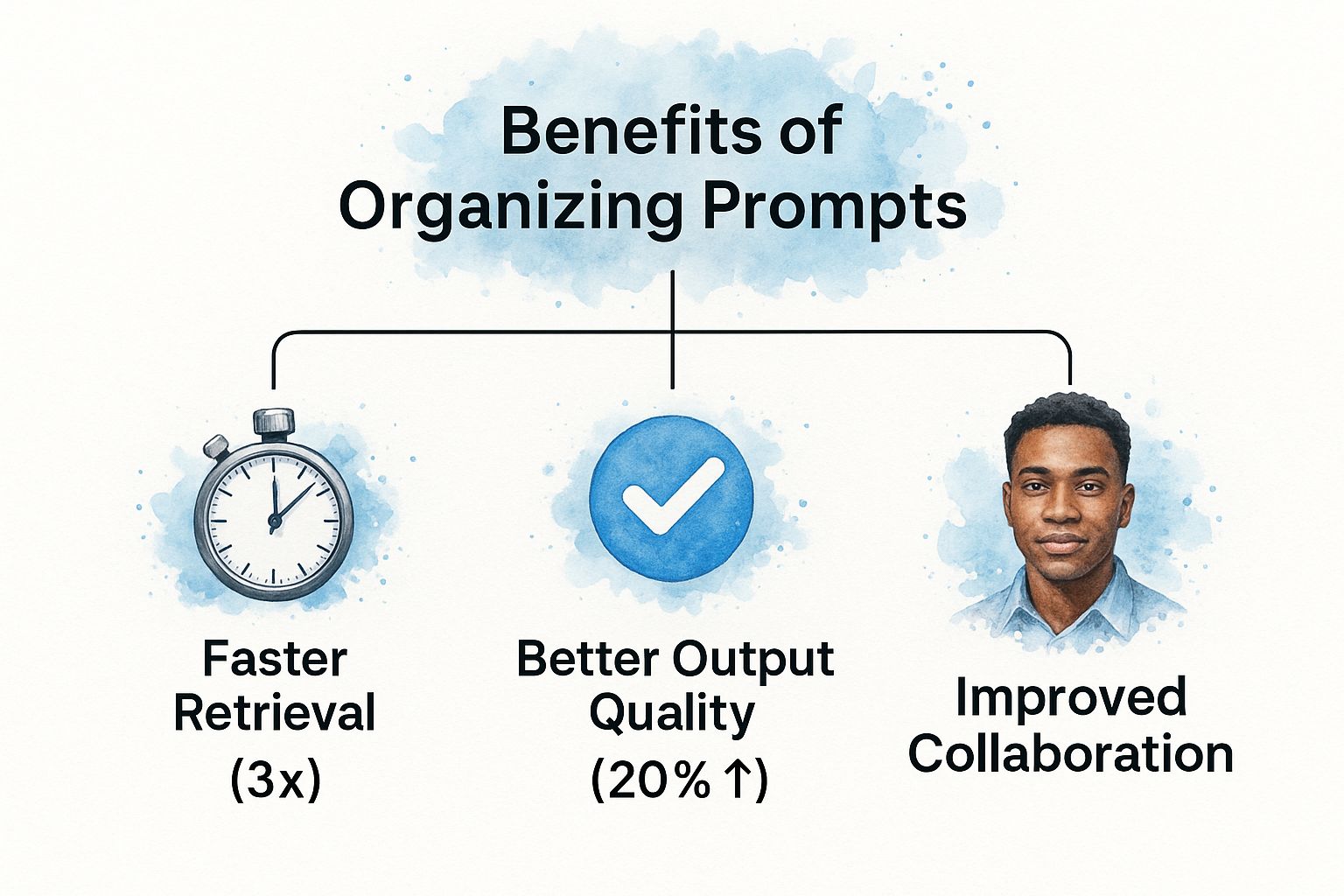Mastering the AI Prompt Library

Think of an AI prompt library as a centralized, curated collection of pre-tested commands—or "prompts"—that are specifically designed to get consistent, high-quality results from artificial intelligence models. It's like having a shared recipe book for AI, making sure everyone is using the best ingredients and instructions to get predictable, delicious outcomes every single time.
What Is an AI Prompt Library

At its heart, a prompt library is about moving away from random, one-off chats with generative AI and toward a structured, scalable process. Instead of every person on your team trying to guess the magic words to get a good response from ChatGPT or Midjourney, they can pull from a collection of proven prompts that just work.
This is way more than just a list of commands saved in a spreadsheet. A real prompt library is a strategic asset for any organization. It becomes the single source of truth for how your company communicates with AI, ensuring that anyone—no matter their skill level—can produce outputs that meet a high standard of quality and brand consistency.
Moving Beyond Simple Lists
While keeping a basic list of prompts is a decent start, a strategic AI prompt library gives you so much more structure and power. It’s the difference between a messy pile of sticky notes and a searchable, indexed cookbook.
To really elevate from a simple list to a strategic asset, a prompt library needs a few core components. These elements are what turn a collection of text into a powerful, scalable system for your entire team.
Core Components of a Strategic AI Prompt Library
| Component | Its Role and Strategic Benefit |
|---|---|
| Categorization | Prompts are tagged and organized by function (e.g., marketing, SEO, code generation) or by AI model. This makes finding the right "recipe" for a specific task quick and painless. |
| Version Control | The best libraries let you update and refine prompts over time, with a history of changes. This is crucial for tracking what works best and continuously improving your outputs. |
| Performance Data | Many platforms include user ratings or performance metrics, helping teams instantly spot the most effective prompts without having to guess. |
| Collaboration | Team members can contribute new prompts, suggest improvements, and share what they've learned. This turns the library into a living hub of collective knowledge. |
These features ensure the library is not just a static document but a dynamic tool that grows and adapts with your team's needs.
A well-managed library democratizes expertise. It captures the knowledge of your best prompt engineers and makes it accessible to the entire organization, dramatically reducing the time it takes for everyone to become proficient with AI tools.
This kind of system is absolutely critical for scaling your AI efforts effectively. Without it, teams are often stuck with inconsistent output quality, duplicated work, and a frustratingly steep learning curve. A library provides the framework for excellence, turning scattered AI use into a repeatable, high-performing workflow.
If you're curious to see these principles in action, you can browse a diverse collection of prompts for artificial intelligence and get a feel for how vetted instructions are organized and presented.
Why Prompt Engineering Is Exploding

Not too long ago, prompt engineering was a niche skill, something AI hobbyists tinkered with. Now, it's become a core business discipline. What changed? Simple: businesses are waking up to the fact that the quality of AI output depends entirely on the quality of the input.
As AI gets woven into the fabric of everything from marketing campaigns to legal reviews, companies need results they can count on. Winging it with haphazard prompts just doesn't cut it—it leads to inconsistent performance, wasted compute time, and unreliable outcomes. This growing dependency on AI is forcing a move toward a more structured, systematic way of communicating with these models.
This is where the idea of a centralized AI prompt library goes from a "nice-to-have" to a "must-have." Companies are quickly realizing that letting every employee figure things out on their own is inefficient and impossible to scale. The smart ones are building systems to manage, test, and deploy their best-performing prompts, ensuring that expert knowledge is captured and shared across the entire organization.
The Market Signals a Major Shift
If you want to know where things are headed, just follow the money. The global prompt engineering market was recently valued at around USD 381.7 million, and it's projected to skyrocket to nearly USD 7.07 billion by 2034. That's a compound annual growth rate of 33.9%. This isn't just a trend; it's a fundamental shift in how businesses operate.
The rapid rise of sophisticated techniques like Retrieval-Augmented Generation (RAG) only underscores how critical high-level prompt engineering has become for getting richer, more accurate AI interactions.
This explosive growth isn't just about writing clever questions for a chatbot. It’s about building repeatable processes that deliver measurable business value. A well-managed AI prompt library acts as the engine for this transformation, turning random AI experiments into a predictable, strategic asset.
For anyone looking to get ahead of the curve, our guide on mastering AI prompt engineering is packed with actionable tips and resources. The move toward organized libraries makes one thing clear: prompt engineering isn't a fad. It's a foundational pillar of modern business strategy.
What Makes a Great Prompt Library?
Let’s be honest, not all prompt collections are built the same. A simple list in a spreadsheet is a decent place to start, but a real AI prompt library is a whole different beast—it's a smart, dynamic system designed to grow with you. The right features can turn that static list into a powerhouse that speeds up your work, boosts quality, and gets the whole team innovating together.
Figuring out what these must-have features are is the first step. Think of it as a checklist to separate a basic list from a high-impact library built for professional teams.
This infographic really nails the core benefits of getting your prompts organized.

As you can see, a well-structured library isn’t just about being tidy. It has a direct, positive effect on how efficiently and effectively you get things done.
The Organizational Basics
The heart of any good library is its ability to make prompts easy to find, understand, and use. Without solid organizational tools, your library will quickly turn into a digital junkyard where great prompts go to die.
Here are the non-negotiables:
- Metadata Tagging: This is all about categorizing prompts by task (like "SEO" or "code generation"), AI model ("ChatGPT-4," "Midjourney"), or even by department ("Marketing," "Sales"). Imagine your marketing team needing a blog post outline—they could instantly filter for every proven prompt you have for that specific task.
- Powerful Search and Filtering: A good search function is a must. Your team needs to find the right prompt fast, whether they’re searching by keyword, tag, or some other piece of metadata. It's a massive time-saver.
Tools for Quality Control and Teamwork
Going beyond simple organization, a truly powerful library needs features that help your team refine prompts and share what they've learned. These are the tools that transform a simple repository into a living, breathing hub of shared expertise.
A shared prompt library is one of the most effective ways to democratize AI skills. It allows teams to develop, standardize, and scale their best practices, ensuring everyone benefits from collective learning.
Here’s what to look for to maintain high quality:
- Version Control: Let’s face it, prompts are rarely perfect on the first go. Version control lets you track changes, compare different attempts, and roll back to a previous version if an update doesn't pan out.
- User Ratings and Feedback: A simple rating system is a game-changer. It helps the best, most effective prompts rise to the top. When team members can upvote prompts that consistently deliver, it creates a quick quality check for everyone else.
- Collaboration Tools: Features that let users comment, suggest edits, or share examples of how they used a prompt create a truly collaborative space. Prompt engineering becomes a team sport where everyone pitches in to build a better resource.
The market for these kinds of tools is heating up. In fact, the AI prompt library management market is expected to grow at a CAGR of 24.8% from 2025 to 2033, all driven by the need for better prompt management. You can read the full market analysis from Dataintelo to see where the industry is headed.
How Prompt Libraries Drive Real Business Outcomes
A well-organized AI prompt library is way more than just a clever productivity hack. Think of it as a strategic engine that directly connects structured AI inputs to real, measurable business wins. When companies graduate from random, one-off commands to a systematic approach, they start seeing serious performance gains everywhere from marketing and sales to customer support.

The magic isn't just about getting things done faster. It’s about boosting the quality and impact of every single thing the AI produces, making sure each output is laser-focused on a specific business goal.
Translating Prompts Into Performance
The connection between great prompts and bottom-line results is becoming undeniable. Recent industry benchmarking reports, which dug into over 2.3 billion prompts, found a direct link between how a prompt is designed and the business outcome it produces. It turns out the best-performing prompts delivered anywhere from 23% to 45% better results than average ones.
For example, marketing campaigns that used ROI-focused prompts saw their effectiveness jump by 42%. In customer service, finely tuned prompts boosted user satisfaction by a massive 45%. You can get all the details in the full industry benchmarking report on TopFreePrompts.com.
This data makes one thing crystal clear: a well-crafted prompt isn't just an instruction—it's a competitive advantage. For any business trying to get the most out of their AI tools, a library is essential for tasks like training your AI Sales Agent for better performance, where consistency is everything.
A prompt library transforms AI from a creative tool into a predictable business asset. It’s where expert knowledge is codified, turning institutional wisdom into a scalable resource that drives consistent, high-quality results.
By embedding your unique business context and expert know-how directly into your prompts, you ensure the AI’s output isn't just good, but strategically valuable.
Key Drivers of Business Impact
So, what turns a simple folder of prompts into a powerhouse for business growth? A few key elements make sure your library is actively contributing to your bottom line, not just gathering digital dust.
Here’s what really moves the needle:
- Embedding Expert Knowledge: The best libraries bottle up the magic of your top performers. Imagine turning your star marketer’s formula for a high-converting ad headline into a prompt that anyone on the team can use.
- Including Rich Business Context: Generic prompts lead to generic results. Simple as that. When you include specific details—like target audience personas, brand voice guidelines, and key performance indicators—you're giving the AI the exact guardrails it needs to create perfectly aligned content.
- Focusing on Repeatable Success: When you find a prompt that nails it, a library makes it dead simple to replicate that win over and over again. This kind of consistency is the bedrock of scaling your operations reliably.
This structured approach is what separates the companies getting real, tangible value from AI from those who are just playing around with it. As AI models and platforms keep getting better, the ability to manage your prompts systematically is going to be non-negotiable. Our guide on exploring the launch of the ChatGPT GPT Store dives into how these new ecosystems are making organized prompt management more critical than ever.
How to Build Your First AI Prompt Library
Building your first AI prompt library might sound like a massive undertaking, but you can get started today with tools you probably already have open. Forget about fancy, dedicated platforms for now. The real goal is to create a simple, effective system that adds a little structure to your AI conversations and can grow with your team.
Let's walk through the process. Think of it as laying the groundwork for a powerful asset that will eventually save time, keep your quality consistent, and help everyone on your team get way better results from AI. The trick is to start small, keep it organized, and focus on capturing what actually works.
Step 1 Start with a Simple Tool
Seriously, don't overcomplicate this. A basic spreadsheet in Google Sheets or Microsoft Excel is the perfect place to start your first prompt library. It’s familiar, easy to share, and flexible enough to get you going without needing to learn any new software.
Right now, the mission is just to stop great prompts from getting buried in endless chat histories or scattered across random documents. Centralizing everything is the single most important first step.
Step 2 Identify Core Business Tasks
Before you write a single prompt, think about the repeatable tasks your team does every day that could get a boost from AI. Don't try to solve every problem at once. Instead, pick a few high-impact areas where consistency is everything.
A few ideas to get the ball rolling:
- Marketing: Generating social media posts, banging out blog post outlines, or drafting ad copy.
- Sales: Crafting personalized outreach emails or summarizing long call transcripts.
- Customer Support: Creating standard, helpful answers to frequently asked questions.
Focusing on specific, recurring tasks ensures your library provides value right out of the gate. This targeted approach makes it much easier to build momentum and get your team excited about using it.
Building a library isn't just about collecting prompts; it's about codifying your team's best practices. One expert suggests legal departments should work together to develop their own library of standard prompts tailored to their specific needs, a strategy that pays off significantly down the road.
This logic applies to any department. When you capture the "recipes" for success, you make that expertise available to everyone, not just the person who figured it out.
Step 3 Create a Basic Prompt Template
Consistency begins with a good template. Having a structured format makes your prompts far easier to read, use, and improve over time. For every prompt you add to your library, you’ll want to include a few key pieces of information. This simple structure is what turns a random list into a genuinely useful database.
Here’s a practical template to get you started. We’ll call it "Your First Prompt Library Template." It's a simple and practical way to document prompts, whether you're using a spreadsheet or a more dedicated tool.
Just create columns for each field and start filling them in.
Your First Prompt Library Template
| Field Name | What to Include | Practical Example |
|---|---|---|
| Prompt Name | A short, descriptive title for the task. | "Create SEO Blog Post Outline" |
| Prompt Text | The full, copy-paste-ready prompt. | "Act as an SEO expert. Create a detailed outline for a blog post about [Topic]..." |
| Category/Tags | Keywords for easy filtering. | SEO, Content Creation, Marketing |
| AI Model | The AI tool it was designed for. | ChatGPT-4, Claude 3, Gemini |
| Notes/Context | Tips on how to use it or what works best. | "Replace [Topic] with your target keyword. Best for listicle-style posts." |
| Version | A simple version number, like 1.0. | 1.1 |
This kind of template ensures every entry is well-organized and has all the context anyone on your team would need to use it effectively. It's a small step that makes a huge difference.
Step 4 Test and Refine Continuously
The first draft of a prompt is almost never the best one. The most valuable prompt libraries are living, breathing documents that evolve. Your goal is to establish a simple workflow for testing and improving your team's prompts.
- Draft an Initial Prompt: Write your first version based on one of those core tasks you identified.
- Test It: Run the prompt through its intended AI model and take a hard look at the output.
- Gather Feedback: Ask a teammate to try the prompt and share their results and thoughts. Was it easy to use? Did the output match their expectations?
- Iterate: Tweak the prompt based on the feedback and your test results. Don't forget to update the "Version" and "Notes" fields in your library!
This simple loop is what transforms a decent prompt into a killer one. Encourage your team to not just be consumers of the library, but contributors. Ask them to suggest improvements and add new prompts that they've found success with.
Common Questions About AI Prompt Libraries
Once teams start getting serious about using AI, a few questions always pop up. Getting straight answers is the key to seeing what a real AI prompt library can do for you and getting past that initial learning curve. Let's tackle some of the most common ones to clear things up.
What Is the Difference Between a Prompt and a Library?
Think of it like this: a prompt is a single ingredient, while a library is the whole recipe book.
A prompt is just one command you give to an AI. It's a single instruction, like, "Write a headline for a blog post about sustainable gardening." A fantastic prompt might give you a fantastic result, but it's a one-and-done deal. Its value is isolated to that single moment.
An AI prompt library, however, is the entire system for managing thousands of those "recipes." It's way more than a list. It's a living collection where your team's best prompts are tested, organized, updated, and shared. A library makes sure everyone can get great results, every time, without reinventing the wheel. It turns those one-off wins into a process that scales.
Can I Just Use a Spreadsheet for My Library?
Absolutely. And honestly, for individuals or small teams just starting out, a spreadsheet is a great first step. Tools like Google Sheets are free, familiar, and give you a basic way to track prompts, add some notes, and sort them into categories. It's a massive improvement over having no system at all.
But as your team gets bigger and you start relying on AI for more complex work, those spreadsheets start to feel pretty limiting. You’ll quickly run into walls because they just don't have features like:
- Version Control: Trying to track how a prompt has evolved over time becomes a manual, messy nightmare.
- Real Collaboration: It's tough to manage who added what, leave feedback, or rate which prompts are actually working in any kind of organized way.
- Seamless Integration: Spreadsheets live outside your AI tools, which means you're stuck in a constant cycle of copy-and-paste.
A spreadsheet is perfect for the "crawl" phase. But to really "walk" and then "run," growing teams need something built for the job.
A shared prompt library is one of the fastest ways to level up your entire team's AI skills. It’s where you build, standardize, and scale what works, making sure everyone learns from the group's successes and avoids making the same mistakes twice.
How Do I Know if a Prompt Is Working Well?
This is the most important question. Figuring out which prompts are effective is how you build a library that actually delivers value. While "good" can be a matter of opinion, "effective" is something you can measure. You need a simple way to separate the heavy hitters from the ones that just don't cut it.
Here are a few practical ways to see what’s working:
- A/B Test the Outputs: Give the AI two different versions of a prompt for the same task. Put the results side-by-side. Which one was more accurate, more creative, or more on-brand?
- Track Time to Completion: How long does it take someone to finish a task using a particular prompt compared to the old way? A solid prompt should slash the time and effort needed.
- Create a Feedback Loop: Add a simple rating system to your library, even just a 1-5 star vote. This lets the team's collective experience bubble up the best, most reliable prompts for everyone to use.
When you're constantly testing and refining, your library stops being a static list and becomes a dynamic tool that gets better and more valuable over time.
Ready to move beyond spreadsheets and build a truly powerful, collaborative library? PromptDen offers the tools you need to organize, share, and monetize your best prompts. Discover thousands of high-quality prompts or start building your team’s shared knowledge base today at https://promptden.com.